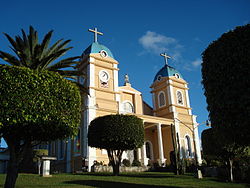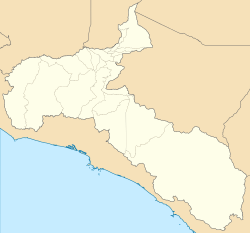You can help expand this article with text translated from the corresponding article in Spanish. (August 2024) Click for important translation instructions.
|
| Tarrazú | |
|---|---|
| Canton | |
 San Marcos Roman Catholic church San Marcos Roman Catholic church | |
 Flag Flag Seal Seal | |
| Tarrazú canton | |
  | |
| Coordinates: 9°34′59″N 84°03′53″W / 9.5830753°N 84.064823°W / 9.5830753; -84.064823 | |
| Country | |
| Province | San José |
| Creation | 7 August 1868 |
| Head city | San Marcos |
| Districts | Districts |
| Government | |
| • Type | Municipality |
| • Body | Municipalidad de Tarrazú |
| • Mayor | Fernando Portuguez Parra (PUSC) |
| Area | |
| • Total | 291.27 km (112.46 sq mi) |
| Elevation | 1,471 m (4,826 ft) |
| Population | |
| • Total | 16,280 |
| • Estimate | 17,810 |
| • Density | 56/km (140/sq mi) |
| Time zone | UTC−06:00 |
| Canton code | 105 |
| Website | munitarrazu |
Tarrazú is the fifth canton in the province of San José in Costa Rica. The head city of the canton is San Marcos. It is part of Los Santos Zone, together with Dota and León Cortés Castro.
History
The canton was established by a legislative decree of 7 August 1868. It was part of the Desamparados canton by that time.
Government
Mayor
According to Costa Rica's Municipal Code, mayors are elected every four years by the population of the canton. As of the latest municipal elections in 2024, the Social Christian Unity Party candidate, Fernando Portuguez Parra, was elected mayor of the canton with 50.15% of the votes, with Marjorie Castro Barrantes and Alejandro Javier Bonilla Herrera as first and second vice mayors, respectively.
| Period | Name | Party |
|---|---|---|
| 2002–2006 | José Rodolfo Naranjo Naranjo | |
| 2006–2010 | Ivan Saurez Sandí | |
| 2010–2016 | Bernardo Barboza Picado | |
| 2016–2020 | Ana Lorena Rovira Gutiérrez | |
| 2020–2024 | ||
| 2024–2028 | Fernando Portuguez Parra |
Municipal Council
Like the mayor and vice mayors, members of the Municipal Council (called regidores) are elected every four years. Tarrazú's Municipal Council has 5 seats for regidores and their substitutes, who can participate in meetings but not vote unless the owning regidor (regidor propietario) is absent. The Municipal Council's composition for the 2024–2028 period is as follows:
 | |||||
| Political parties in the Municipal Council of Tarrazú | |||||
|---|---|---|---|---|---|
| Political party | Regidores | ||||
| № | Owner | Substitute | |||
| Social Christian Unity Party (PUSC) | 3 | Keisy Daniela Gutiérrez Valverde | María Victoria Naranjo Abarca | ||
| Carlos Luis Abarca Cruz | Juan Diego Blanco Valverde | ||||
| Melania Chaves Chanto | Karen Lizeth Vargas Navarro | ||||
| National Liberation Party (PLN) | 2 | Karol Tatiana Navarro Monge | María Rosario Umaña Retana | ||
| Wilmer Alvarado Fonseca | Isaac Facundo Madrigal Vargas | ||||
Geography

Tarrazú has an area of 291.27 square kilometres (112.46 sq mi) and a mean elevation of 1,471 metres (4,826 ft).
The Pirrís River (also known as Parrita River) establishes much of the northern boundary of the three-pronged canton, which reaches south across the Coastal Mountain Range to its border with the canton of Quepos in Puntarenas Province.
Tarrazú is located about 70 kilometres (43 mi) south of the capital, San José, in a pristine valley surrounded by mountains that are part of the Talamanca Sierra in southern Costa Rica. Downtown San Marcos is 1,350 metres (4,430 ft) above sea level but is surrounded by peaks as high as 3,000 metres (9,800 ft) above sea level.
Districts
The canton of Tarrazú is subdivided into three districts:
Demographics
| Census | Pop. | ±% p.a. |
|---|---|---|
| 1883 | 1,378 | — |
| 1892 | 2,583 | +7.23% |
| 1927 | 5,734 | +2.30% |
| 1950 | 7,435 | +1.14% |
| 1963 | 5,392 | −2.44% |
| 1973 | 7,542 | +3.41% |
| 1984 | 8,845 | +1.46% |
| 2000 | 14,160 | +2.98% |
| 2011 | 16,280 | +1.28% |
| 2022 | 17,810 | +0.82% |
| Source: Instituto Nacional de Estadística y Censos Centro Centroamericano de Población | ||
Tarrazú had an estimated population of 17,810 in 2022, an increase from its 16,280 inhabitants at the time of the 2011 census.
In 2022, Tarrazú had a Human Development Index of 0.668.
Transportation
Road transportation
The canton is covered by the following road routes:
Economy
Highland coffee is the main source of income of local people. However, tourism and avocado production are of increased importance. During the months of December, January and February, population increases three-fold due to harvest time. San Marcos, the biggest town in the region, has become the center of economic activity.
More recently, the Costa Rican Institute of Electricity has invested millions of dollars in the Pirrís Hydro Dam, scheduled to start generating energy by March 2011. The Hydro Dam is now the highest structure of its kind in Central America and will be key to the economic development of the region, not only in the highlands but the coastal regions of Quepos and Parrita.
The region is deeply dependent on remittances from emigres who live in the United States, namely New Jersey. Few households in the region do not have a family member who lives and works in the United States. This outmigration has led to an influx of thousands of Panamanian laborers to help realize the annual coffee harvest.
Tarrazú, particularly the San Lorenzo area, is felt to produce the most desirable coffee in Costa Rica. Finca Palmilera coffee is grown here. In November 2012, it was the most expensive coffee sold in Starbucks coffee shops in the United States.
References
- ^ "Declara oficial para efectos administrativos, la aprobación de la División Territorial Administrativa de la República N°41548-MGP". Sistema Costarricense de Información Jurídica (in Spanish). 19 March 2019. Retrieved 26 September 2020.
- División Territorial Administrativa de la República de Costa Rica (PDF) (in Spanish). Editorial Digital de la Imprenta Nacional. 8 March 2017. ISBN 978-9977-58-477-5.
- Hernández, Hermógenes (1985). Costa Rica: evolución territorial y principales censos de población 1502 - 1984 (in Spanish) (1 ed.). San José: Editorial Universidad Estatal a Distancia. pp. 164–173. ISBN 9977-64-243-5. Retrieved 5 October 2020.
- ^ Asamblea Legislativa de la República de Costa Rica (13 May 2024). "Código Municipal" [Municipal Code]. Sistema Costarricense de Información Jurídica (in Spanish).
- Tribunal Supremo de Elecciones (21 February 2024). "N.° 1658-E11-2024 - Declaratoria de elección de alcaldías y vicealcaldías de las municipalidades de los cantones de la provincia de San José, para el período comprendido entre el primero de mayo de dos mil veinticuatro y el treinta de abril de dos mil veintiocho" (in Spanish). Retrieved 12 August 2024.
- Tribunal Supremo de Elecciones. "Resoluciones declaratorias de elección". Tribunal Supremo de Elecciones (in Spanish). Retrieved 12 August 2024.
- Tribunal Supremo de Elecciones (12 February 2024). "N.° 2218-E11-2024 - Declaratoria de elección de regidurías de las municipalidades de los cantones de la provincia de San José, para el período comprendido entre el primero de mayo de dos mil veinticuatro y el treinta de abril de dos mil veintiocho" (in Spanish). Retrieved 12 August 2024.
- Instituto Geográfico Nacional de Costa Rica (20 June 2024). "División Territorial Administrativa, 2024 – Totales de Provincias, Cantones y Distritos de Costa Rica" [Administrative Territorial Division, 2024 – Totals of Provinces, Cantons and Districts of Costa Rica] (PDF) (in Spanish).
- "Instituto Nacional de Estadística y Censos" (in Spanish).
- Centro Centroamericano de Población de la Universidad de Costa Rica. "Sistema de Consulta a Bases de Datos Estadísticas" (in Spanish).
- Instituto Nacional de Estadística y Censos (July 2023). Estimación de Población y Vivienda 2022 : Resultados Generales [2022 Population and Housing Estimate : General Results] (PDF) (in Spanish). ISBN 9789930525753. Retrieved 12 August 2024.
- "Censo. 2011. Población total por zona y sexo, según provincia, cantón y distrito" (in Spanish). Instituto Nacional de Estadística y Censos. Retrieved 26 September 2020.
- Sistema Nacional de Información y Registro Único de Beneficiarios del Estado; Escuela de Estadística de la Universidad de Costa Rica; Programa de las Naciones Unidas para el Desarrollo (9 June 2023). "Atlas de Desarrollo Humano Cantonal en Costa Rica, 2022". Retrieved 12 August 2024.
- Kordick, Carmen. The Saints of Progress: Coffee, Migration, and Costa Rican National Identity. University of Alabama Press, 2019.
- Elizabeth Barham, Bertil Sylvander (24 June 2011). Labels of Origin for Food: Local Development, Global Recognition. CABI. p. 146. Retrieved 7 July 2012.
- "Costa Rica Finca Palmilera", Roy Street Coffee and Tea. Retrieved 16 November 2012.
- Josh Sanburn (30 November 2012). "The $7 Cup of Starbucks: A Logical Extension of the Coffee Chain's Long-Term Strategy". Time.
| Provinces and cantons of Costa Rica | ||
|---|---|---|
| Alajuela | ||
| Cartago | ||
| Guanacaste | ||
| Heredia | ||
| Limón | ||
| Puntarenas | ||
| San José | ||